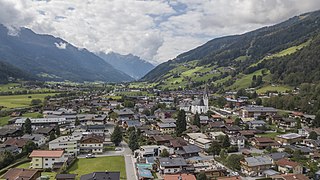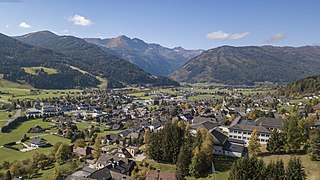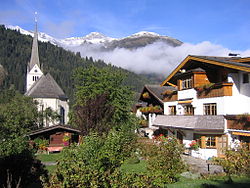
Salzburg is an Austrian federal state. In German it is called a Bundesland, a German-to-English dictionary translates that to federal state and the European Commission calls it a province. In German, its official name is Land Salzburg, to distinguish it from its eponymous capital Salzburg. For centuries, it was an independent Prince-Bishopric of the Holy Roman Empire. It borders Germany and Italy.

Bischofshofen is a town in the district of St. Johann im Pongau in the Austrian federal state of Salzburg. It is an important traffic junction located both on the Salzburg-Tyrol Railway line and at the Tauern Autobahn, a major highway route crossing the main chain of the Alps.

Mittersill is a city in the federal state of Salzburg, Austria, in the Pinzgau region of the Alps. It is located on the Salzach River. It has a population of 5,408 as of 2011.

Krimml is a municipality in Zell am See District, in the federal state of Salzburg, Austria, in the Pinzgau region.

Mauterndorf is a market town of the Tamsweg District in the Austrian state of Salzburg. The municipality also comprises the Katastralgemeinden Faningberg, Neuseß and Steindorf.

Lofer is a market town in the district of Zell am See in the Austrian state of Salzburg.

Muhr is a municipality of the Tamsweg District in the Austrian state of Salzburg.

Fusch an der Großglocknerstraße is a municipality, at the foot of Grossglockner mountain, in the district of Zell am See, in the state of Salzburg in Austria. The Fusch valley lies north of the main chain of the Alps. The population is 697. Fusch has an elevation of 813 metres (2,667 ft), but the maximum elevation within the municipality is 3,564 metres (11,693 ft), rising up Grossglockner mountain.

Tamsweg is a market town in the Austrian state of Salzburg near the border with Styria. It is the administrative centre of the eponymous Tamsweg District (Bezirk) and the largest town of the Salzburg Lungau region.

Zederhaus is a municipality of the Tamsweg District in the Austrian state of Salzburg.

Flattach is a municipality in Spittal an der Drau District in the Austrian state of Carinthia.

Radstadt is a historic town in the district of St. Johann im Pongau in the Austrian state of Salzburg.

Krems in Kärnten is a municipality in the district of Spittal an der Drau in Carinthia in Austria.

Obervellach is a market town in the district of Spittal an der Drau, in the Austrian state of Carinthia.

Bruck an der Großglocknerstraße is a municipality in Zell am See District, in the state of Salzburg in Austria.

Bramberg am Wildkogel is a municipality in the district of Zell am See, in the state of Salzburg, Austria. The town lies at the south foot of the 2,225-metre (7,300 ft) high Wildkogel mountain. The town's average elevation is 819 metres (2,687 ft).

St. Michael im Lungau is a market town in the district of Tamsweg in the Austrian state of Salzburg.

Untertauern is a municipality in the district of St. Johann im Pongau in the Austrian state of Salzburg.

The Goldberg Group is a sub-group of the Hohe Tauern mountain range within the Central Eastern Alps. It is located in Austria, in the states of Salzburg and Carinthia. Its highest peak is the Hocharn, 3,254 m (AA). Other well known summits are the Hoher Sonnblick, with its observatory at 3,106 m above sea level (AA), and the Schareck at 3,123 m above sea level (AA)

The word Tauern is German and originally meant 'high mountain pass' in the Austrian Central Alps, referring to the many bridleways and passes of the parallel side valleys of the River Salzach that cut into the mountain ranges. From the Middle Ages, when mining reached its heyday, the word Tauern was also used to name the corresponding ranges. The name has survived in many local placenames today.























